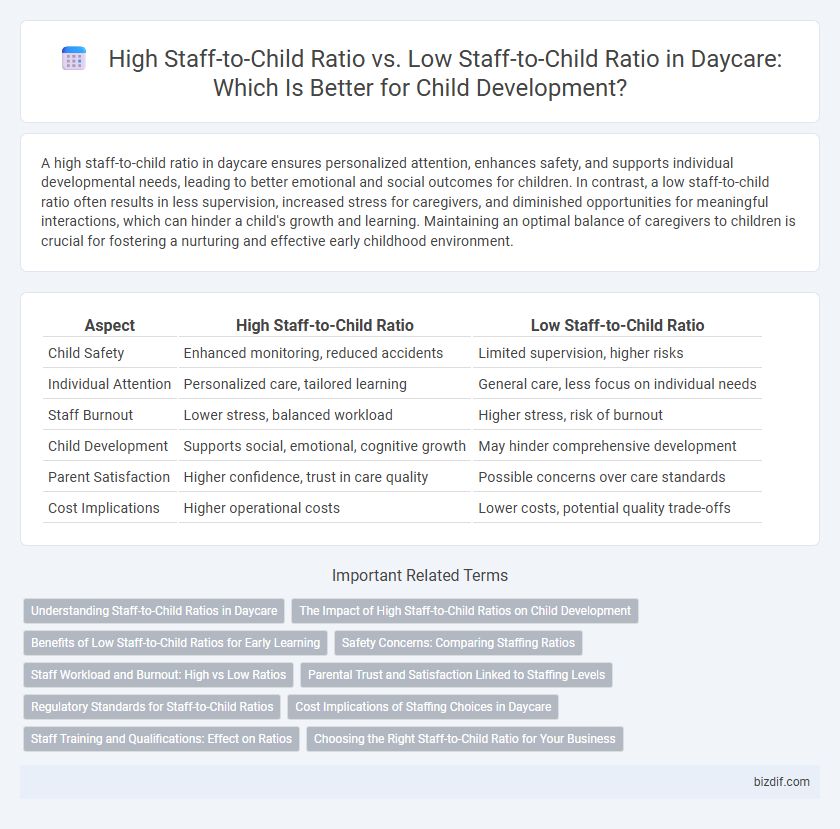A high staff-to-child ratio in daycare ensures personalized attention, enhances safety, and supports individual developmental needs, leading to better emotional and social outcomes for children. In contrast, a low staff-to-child ratio often results in less supervision, increased stress for caregivers, and diminished opportunities for meaningful interactions, which can hinder a child's growth and learning. Maintaining an optimal balance of caregivers to children is crucial for fostering a nurturing and effective early childhood environment.
Table of Comparison
| Aspect | High Staff-to-Child Ratio | Low Staff-to-Child Ratio |
|---|---|---|
| Child Safety | Enhanced monitoring, reduced accidents | Limited supervision, higher risks |
| Individual Attention | Personalized care, tailored learning | General care, less focus on individual needs |
| Staff Burnout | Lower stress, balanced workload | Higher stress, risk of burnout |
| Child Development | Supports social, emotional, cognitive growth | May hinder comprehensive development |
| Parent Satisfaction | Higher confidence, trust in care quality | Possible concerns over care standards |
| Cost Implications | Higher operational costs | Lower costs, potential quality trade-offs |
Understanding Staff-to-Child Ratios in Daycare
A high staff-to-child ratio in daycare centers ensures individualized attention, enhanced safety, and better developmental support for each child, fostering a nurturing environment conducive to learning. Conversely, a low staff-to-child ratio may lead to less supervision, increased stress among caregivers, and diminished quality of care, potentially impacting children's emotional and cognitive growth. Understanding these ratios helps parents and administrators prioritize staffing levels that promote optimal child development and well-being.
The Impact of High Staff-to-Child Ratios on Child Development
High staff-to-child ratios in daycare settings significantly enhance individualized attention, supporting cognitive, social, and emotional development by allowing caregivers to engage more effectively with each child. This increased interaction fosters stronger language acquisition, better emotional regulation, and improved problem-solving skills. Research indicates that children in high staff-to-child ratio environments exhibit higher levels of confidence and cooperative behavior compared to those in settings with lower ratios.
Benefits of Low Staff-to-Child Ratios for Early Learning
Low staff-to-child ratios in daycare settings significantly enhance early learning by allowing caregivers to provide individualized attention tailored to each child's developmental needs. This personalized interaction supports cognitive growth, social skills, and emotional regulation more effectively than settings with higher ratios. Studies show that children in low-ratio environments demonstrate improved language acquisition, problem-solving abilities, and stronger attachments to their caregivers.
Safety Concerns: Comparing Staffing Ratios
A high staff-to-child ratio in daycare centers significantly enhances safety by allowing caregivers to closely monitor each child, swiftly respond to emergencies, and prevent accidents. Conversely, a low staff-to-child ratio increases risks of inadequate supervision, raising the potential for overlooked hazards and delayed intervention during critical situations. Regulatory agencies often mandate minimum staffing levels to ensure optimal safety and promote a secure environment for young children's development.
Staff Workload and Burnout: High vs Low Ratios
High staff-to-child ratios significantly reduce individual workload for daycare employees, enhancing their ability to provide attentive care and support to each child. In contrast, low staff-to-child ratios increase workload, leading to higher stress levels and a greater risk of staff burnout. Maintaining optimal staff-to-child ratios is crucial for sustaining caregiver well-being and ensuring quality early childhood education.
Parental Trust and Satisfaction Linked to Staffing Levels
High staff-to-child ratios in daycare centers significantly enhance parental trust by ensuring individualized attention and prompt response to children's needs. Research links higher staffing levels to increased parental satisfaction due to improved child safety, development, and well-being. Centers maintaining optimal staff-to-child ratios demonstrate better communication with parents, fostering stronger relationships and confidence in the quality of care provided.
Regulatory Standards for Staff-to-Child Ratios
Regulatory standards for staff-to-child ratios ensure optimal supervision and safety in daycare settings, typically requiring lower ratios for infants (e.g., 1:3) compared to older children (e.g., 1:10). Higher staff-to-child ratios correlate with improved child development outcomes and reduced risks of accidents or neglect. Compliance with these mandated ratios is critical to maintaining licensing and fostering a positive learning environment.
Cost Implications of Staffing Choices in Daycare
High staff-to-child ratios in daycare settings typically lead to increased operational costs due to higher salaries and training expenses for more caregivers. Conversely, low staff-to-child ratios reduce staffing expenditures but may compromise quality of care and safety, potentially resulting in long-term financial liabilities or lower enrollment rates. Balancing staffing levels is crucial to maintaining affordable fees while ensuring compliance with regulatory standards and meeting parental expectations.
Staff Training and Qualifications: Effect on Ratios
High staff-to-child ratios are often linked with more rigorous staff training and higher qualifications, enhancing individualized care and safety in daycare settings. Well-trained caregivers can manage larger groups effectively while maintaining quality interaction and supervising children's activities. Conversely, low staff-to-child ratios typically require fewer qualified staff, which may compromise developmental support and responsiveness to children's needs.
Choosing the Right Staff-to-Child Ratio for Your Business
Selecting the appropriate staff-to-child ratio directly impacts the quality of care and safety in a daycare setting, with higher ratios allowing more personalized attention and fostering better child development. Licensing regulations often dictate minimum requirements, but exceeding these standards can enhance caregiver responsiveness and parental trust. Evaluating factors such as age group, facility size, and budget helps determine the optimal ratio to maintain both operational efficiency and superior child outcomes.
High Staff-to-Child Ratio vs Low Staff-to-Child Ratio Infographic

 bizdif.com
bizdif.com